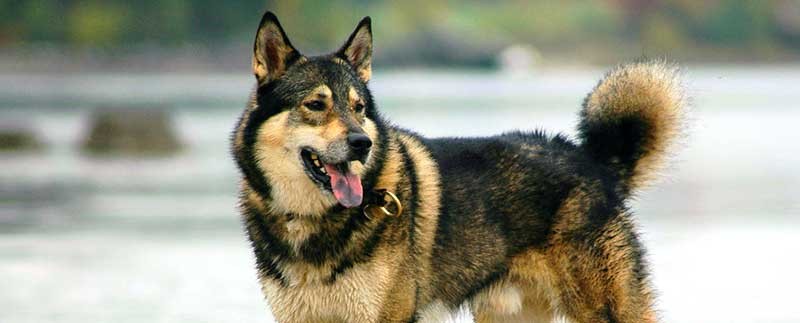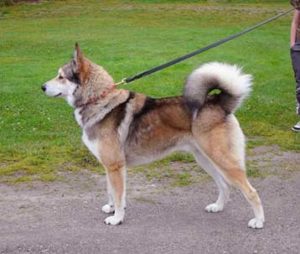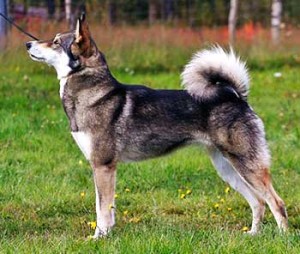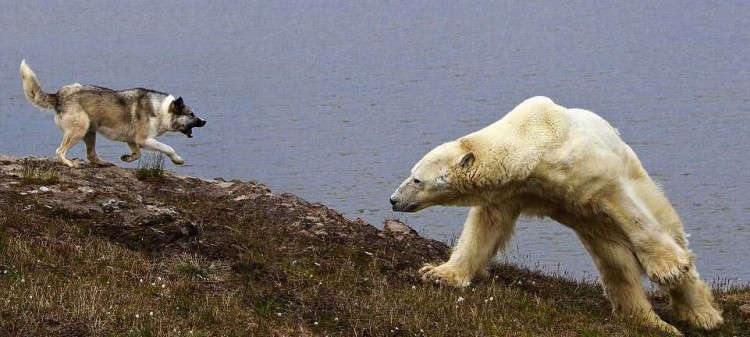The East Siberian Laika (ESL) or Vostotchno-Sibirskaïa Laïka is a Spitz type hunting dog originating from the Siberian territory east of the Yenisei River and Lake Baikal. Similar to the West Siberian Laika, the ESL was developed from the aboriginal Laikas used for hunting and sled pulling. However, these dogs have been located in the Amur River region, Evenkiysky District, Irkutsk Province, and Primorsky Krai in the far east of Siberia. They are known to share many common things with their wild ancestors, wolves, and are of the similar ancient origin like Mansi and Khanty dogs. In fact, experts believe that they were brought in these lands by migrating tribes from the west. That is why the West Siberian and East Siberian Laikas are quite similar in their appearance and behavior. However, these East Siberian dogs, especially those from the Vladivostok and lower Amur River basin, share some traits with Chinese and Japanese dogs. These traits are probably in connection with interbreeding between some of these Laikas and dogs brought from China and Mongolia by migrating tribes.
The first breed standard was established in 1947 by K. G. Abramov. However, since it was based only on hunting and sled pulling Laikas from the Amur River region, it was rewritten at the beginning 1960s. At that time, people began interbreeding these ESLs with the lighter hunting dogs from other regions of East Siberia. Unfortunately, the pure indigenous Laikas started to disappear in some parts of East Siberia, especially, in and near big cities as well as in the Amur River basin. So, under such circumstances, a special breeding program was organized during 1970s by the government kennel in Irkutsk and Leningrad with the idea to save and further establish this incredibly potent hunting breed. This is when the breed maintained its modern shape and look. Today, the numbers of East Siberian Laikas are steadily increasing. In fact, it is one of three most popular and most numerous Laika breeds in the world, other two being the Russo-European Laika and already mentioned West Siberian Laika. All three breeds are by the FCI included in the group 2: Nordic Hunting Dogs in the class of primitive dogs.
Contents
East Siberian Laika Personality And More
The East Siberian Laika is the largest of all hunting Laika breeds. This dog is primarily bred for hunting and sled pulling in its native country, but it is also known as a wonderful family companion and an excellent guard and watchdog. The ESL is very affectionate and loyal to all family members, including kids. Indeed, he can be a lovely playmate for every child, especially if they were raised together. He is usually very playful, good and tolerant with children, but keep in mind that ESL will protect your child if he finds necessary. This can sometimes be a problem in the case a Laika is playing with yours and children from the neighborhood. So, if your dog is not properly socialized, you will have to pay extra attention to the way they are treating each other. Apart from this, the East Siberian Laika is truly a loyal and caring companion, who will enjoy every moment spent in the company of its loved ones and above all its primary owner. Of course, the primary owner is the one to whom this dog will be absolutely devoted and loyal.
Main East Siberian Laika characteristics are agility, speed, endurance, boldness, strength, intelligence, resourcefulness, stubbornness, persistence, independence, alertness, and loyalty. This dog is very sensitive to changes in his surroundings. He will notify you with intensive barking if there’s anything suspicious going on near your property. Luckily, ESL is not prone to excessive barking like some other Laika breeds. However, that doesn’t mean this dog will happily welcome unfamiliar guests. The Vostotchno-Sibirskaïa Laïka is known to be rather cautious and restrained with strangers, and it won’t allow to be petted by them. The true potential of this dog as a good guardian lies in the fact that he is very protective of his territory/owner’s property. So, you can be sure he won’t hesitate to confront any intruder at sight. Luckily, the East Siberian Laika usually won’t bite nor act too aggressively in such situations, unless trained otherwise, but will intimidate almost anyone that steps into your yard uninvited.
The East Siberian Laika lifespan is usually around 10-12 years. This is a very healthy breed susceptible only to some common dog diseases and parasites. Although the ESL is the calmest and quietest of all hunting Laikas, it doesn’t mean this is some bored and lazy pet. On the contrary, this is a very athletic and agile dog, which is always ready for some action. So, in order to keep your dog healthy in every way, you will have to exercise him a lot, at least, one hour a day. It would be best that you combine long walks with challenging games. It doesn’t matter which way you’ll do it, but you should never skip it. You can, of course, take him for a walk a few times a day if you wish. Remember, you must dedicate a lot of attention to your Laika and make it active as much as possible. This way only you will be sure your dog won’t become bored, anxious or prone to various behavior issues. That is why the East Siberian Laika is an ideal companion for owners who ordinarily practice jogging, camping or hiking in the wilderness.
Living Conditions
Surely the East Siberian Laika can be a very gentle and well-tempered dog, but that certainly doesn’t mean it is a good pet for keeping in an apartment or a house. In fact, this dog is not suited to any kind of urban environment, unless there is a large park close by. So, if you live in a large city or a house without a yard, it would be best that you skip this breed. Of course, the ESL won’t mind to be petted indoors for some time, but in order to keep this dog properly, it is necessary that you have a very large yard with grass and trees. Only in such living place your Laika will have just enough space for its little games and other activities. Now, when you read this, it is perfectly clear that ESL is an ideal dog for people living in some rural area surrounded by rich nature. After all, in their native country these dogs have been mainly kept in remote villages in taiga and tundra regions. They are known to greatly enjoy roaming and exploring their surroundings, it’s in their blood. So, being a part of nature is something that is very important to every East Siberian Laika.
ESL With Other Dogs And Pets And Training
The East Siberian Laika was primarily bred and used for hunting – it is something that is embedded in its genes. So, it is understandable that this dog possesses a very, very strong prey drive. In fact, an ESL will start developing its hunting instincts in early puppyhood. It is the reason this Laika breed is highly prized as a hunting dog, but at the same time it can only mean trouble for other pets. Indeed, Vostotchno-Sibirskaïa Laïka can be a real terror for small pets as well as small farm animals. It will gladly chase and hunt down every cat, rodent, rabbit or chicken at sight. The things tend to be a bit better when it comes to other dogs. Usually, an ESL will be friendly with the dogs he meets when outside. However, any unfamiliar dog, especially the one of the same sex that comes near its territory will be treated dominantly and aggressively. The East Siberian Laika will pick a fight with such dog intruders in no time, doesn’t matter how big or strong they are. So, the question is, how to deal best with these two problems?
Of course, the most reliable and recommended method to deal with this is that you raise your East Siberian Laika with other dogs, pets, and farm animals. This way your dog will surely get used to them and will learn to ignore them. However, if you have rabbits and chickens, know that they will never be safe with this Laika around. They are just too tempting. So, make sure you keep them behind secured fence. This can be as well said for cats from the neighborhood. While the ESL can become friendly with owner’s cats, this cannot guarantee safety for other cats around. So, in order to deal with this, you will have to socialize and train your dog in obedience. But, how well does an East Siberian Laika responds to training in general? The answer is quite well. This is a very intelligent dog with good memory, who is eager to please. In the skillful hands, he can become obedient relatively easy. The key is to start with socialization and training as soon as possible, at the age of five weeks, and to apply positive reinforcement techniques without bullying or yelling.
Vostotchno-Sibirskaïa Laïka Physical Characteristics
The East Siberian Laika is a large dog of square shape – its length and height at withers are of similar measures. Like the West Siberian Laika, ESL has a wolf-like appearance. Its body is very muscular, slender, and compact, with the well defined withers and broad croup that is slightly lower. The thick, medium length double coat is made of a soft, dense and woolly undercoat and a straight and coarse protective topcoat. The hair is longer around the head and neck (forming collar), on the shoulders, buttocks, and lower side of the tail. The length and density of coat can vary depending on the type of climate in an area, but the ESL is in the first place recommended to the people living in the northern hemisphere. If you, however, live in a warmer climate, you should avoid exercising your Laika during very hot days. You should groom your dog once a week, but during shedding periods a daily brushing is required. Main East Siberian Laika colors are white, grey, black, red/tan, pepper and salt, and different shades of brown. Patches and limbs ticked in the body color are allowed. The preferred color pattern is a combination of black and tan with lighter patches.
The Vostotchno-Sibirskaïa Laïka has the wolfish, wedge-shaped head with the straight, pointy muzzle and the broad skull. The skull and muzzle are approximately of the same length. The teeth meet in the scissors bite. The rounded nose is usually black, but can be as well brown, although rarely. The well furred, triangular ears are rather small and erect. The dark brown, oval-shaped eyes are quite small and slanting. You should inspect the ESL‘s eyes and ears once a month. The very strong neck is about the same length as the head. The broad chest with the well sprung ribs is deep. The brushy tail is usually carried curled or in the shape of a sickle atop the dog’s straight and muscular back. The front legs are straight, long, and parallel. The hind legs are well-angled, parallel, muscular, and very firm. The rounded feet with hard pads are well insulated. Keep in mind that the proportions and some physical characteristics can vary in East Siberian Laikas depending on the region of origin. This is the reason ESL is definitely not suited for showmanship competitions.
East Siberian Laika Dog Size And Weight
Male
– Height between 22 and 26 inches (56-66 cm)
– Weight between 50 and 70 pounds (23-32 kg)
Female
– Height between 20 and 24 inches (50-60 cm)
– Weight between 45 and 65 pounds (20-30 kg)
Very Efficient Hunting Dog
The East Siberian Laika is literally a beast when it comes to hunting. There are so many things about the ESL to support this claim. This dog possesses very strong hunting instincts combined with the incredible endurance, crazy persistence, keen senses of scent and sight, boldness, strength, and a great sense of direction. It can easily work in any weather conditions across the harshest of terrains, whether it is deep snow, thick forest, rocky mountain or freezing tundra. Vostotchno-Sibirskaïa Laïka is a fierce hunter that will aggressively confront even the most dangerous wild predators. It is used in the hunt on various types of small and large game – from marten, sable, grouse or squirrel to elk, moose, bear, wolf or boar. This is a typical bay hunting dog that is equally successful in trapping and treeing. The East Siberian Laika silently tracks down an animal until it spots it. Then, it starts chasing it and dashing at it while barking continuously. This way the ESL traps a game and keep it at bay until the hunter arrives.
Working Dog Of Many Qualities
Apart from being known as a great hunting dog, wonderful companion, and an excellent watchdog, the East Siberian Laika is also known as a good working dog of many qualities. Unlike other hunting Laika breeds, this one is ordinarily used for sled pulling. This comes as no surprise considering how big, strong, hardy, and light on feet this dog really is. As a proof of the ESL‘s diverse capabilities serves a fact that in some parts of East Siberia these dogs are successfully used as reindeer herders. Also, in some remote villages and camps, they are often used as reliable protectors against wild predators that frequent these settlements for food. Now, when you look at these facts, it is obvious that this breed is similar to a West Siberian Laika for many reasons. The one another such reason, which is very important if you intend to breed your Laika, is that females come into estrus once a year, between January and March. So, there you have it, things you need to know about this beautiful breed in a nutshell. And, as you can see, the East Siberian Laika is a perfect dog for every hunter, farmer or an active man. If you are one of these, I’m sure this dog will be your ideal companion!
1 156






The picture of the red and white dog labeled “Beautiful, agile and strong!” is actually a West Siberian Laika named Kazyr. He lives in Kentucky.
Thanks for the heads up! I’ll fix that as soon as possible! Honestly, the East Siberian Laika dogs have really varying appearances depending on the part of the East Siberia they are coming from….